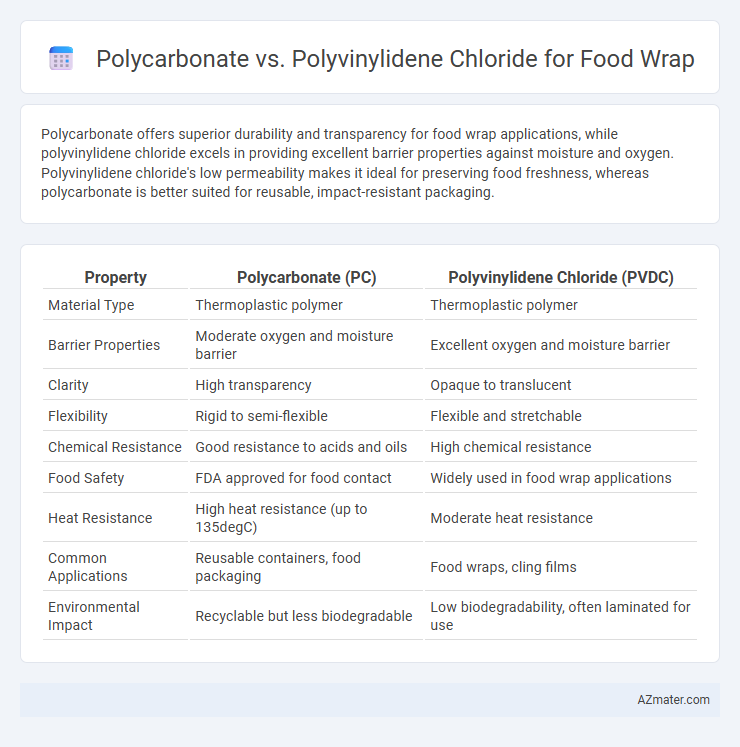Polycarbonate offers superior durability and transparency for food wrap applications, while polyvinylidene chloride excels in providing excellent barrier properties against moisture and oxygen. Polyvinylidene chloride's low permeability makes it ideal for preserving food freshness, whereas polycarbonate is better suited for reusable, impact-resistant packaging.
Table of Comparison
| Property | Polycarbonate (PC) | Polyvinylidene Chloride (PVDC) |
|---|---|---|
| Material Type | Thermoplastic polymer | Thermoplastic polymer |
| Barrier Properties | Moderate oxygen and moisture barrier | Excellent oxygen and moisture barrier |
| Clarity | High transparency | Opaque to translucent |
| Flexibility | Rigid to semi-flexible | Flexible and stretchable |
| Chemical Resistance | Good resistance to acids and oils | High chemical resistance |
| Food Safety | FDA approved for food contact | Widely used in food wrap applications |
| Heat Resistance | High heat resistance (up to 135degC) | Moderate heat resistance |
| Common Applications | Reusable containers, food packaging | Food wraps, cling films |
| Environmental Impact | Recyclable but less biodegradable | Low biodegradability, often laminated for use |
Introduction to Food Wrap Materials
Food wrap materials primarily require excellent barrier properties, flexibility, and safety for preserving food freshness. Polycarbonate offers high durability and clarity but lacks superior moisture and gas barrier characteristics compared to Polyvinylidene chloride (PVDC), which excels in blocking oxygen, water vapor, and aromas to extend shelf life. PVDC is widely favored in food packaging for its exceptional protective qualities, whereas polycarbonate is more common in reusable or rigid packaging applications.
Overview of Polycarbonate (PC)
Polycarbonate (PC) is a durable, transparent thermoplastic widely used in food wrap applications due to its excellent impact resistance and high clarity. Its inherent toughness and thermal stability make it suitable for protecting food while maintaining visibility, surpassing Polyvinylidene chloride (PVDC) in mechanical strength. PC's resistance to chemicals and low moisture permeability contribute to better preservation and extended shelf life for food products.
Overview of Polyvinylidene Chloride (PVDC)
Polyvinylidene chloride (PVDC) is a highly effective barrier polymer commonly used in food wrap applications due to its superior oxygen, moisture, and aroma barrier properties. Unlike polycarbonate, PVDC exhibits excellent chemical resistance and low permeability, which significantly extends the shelf life of perishable food products by preventing contamination and spoilage. Its flexibility and clarity make PVDC ideal for maintaining food freshness while providing strong protection against environmental factors.
Barrier Properties: Moisture and Gas Permeability
Polyvinylidene chloride (PVDC) exhibits superior barrier properties compared to polycarbonate, with significantly lower moisture vapor transmission rates (MVTR) and excellent resistance to oxygen permeability, essential for preserving food freshness. Polycarbonate, while known for its toughness and thermal stability, has higher moisture and gas permeability, making it less effective as a barrier in food wrap applications. The dense polymer structure of PVDC reduces the passage of gases and moisture, extending shelf life by protecting food from oxidation and dehydration more effectively than polycarbonate.
Durability and Strength Comparison
Polycarbonate offers superior durability and impact resistance compared to polyvinylidene chloride (PVDC), making it less prone to cracking or tearing during use. PVDC excels in barrier properties but tends to be less mechanically robust, with lower tensile strength and flexibility than polycarbonate. For food wrap applications requiring long-lasting strength and protection against physical damage, polycarbonate provides a more resilient solution.
Food Safety and Chemical Migration Risks
Polyvinylidene chloride (PVDC) offers superior barrier properties against oxygen and moisture compared to polycarbonate (PC), reducing the risk of food spoilage and extending shelf life in food wrap applications. PC, while durable and clear, poses higher chemical migration risks due to potential bisphenol A (BPA) leaching, raising safety concerns for food contact materials. PVDC's low permeability and chemical inertness make it a safer choice for food safety, minimizing the transfer of harmful substances into wrapped food products.
Environmental Impact and Recycling
Polycarbonate food wraps pose environmental challenges due to BPA content and difficulties in recycling, resulting in limited eco-friendly disposal options. Polyvinylidene chloride (PVDC) food wraps offer superior barrier properties and are less toxic but present recycling complexities because of chlorine content that can release harmful substances during incineration. Both materials contribute to plastic waste concerns, yet advances in biodegradable alternatives and improved recycling technologies are essential to mitigate their environmental impact.
Cost and Market Availability
Polycarbonate food wrap offers moderate cost with durable, clear properties but is less commonly available compared to polyvinylidene chloride (PVDC), which commands a higher price point due to superior barrier performance against moisture and oxygen. PVDC food wrap dominates the market in applications requiring extended shelf life, benefiting from established manufacturing infrastructure and widespread distribution. Cost-efficiency and availability factors favor polycarbonate for general-purpose food wrapping, while PVDC is preferred for premium preservation needs despite its higher expense.
Typical Applications in the Food Industry
Polycarbonate is rarely used for food wrap due to its rigidity and higher cost, but it is common in reusable food containers and protective packaging where transparency and impact resistance are required. Polyvinylidene chloride (PVDC) is widely employed in food wraps because of its excellent barrier properties against oxygen, moisture, and aromas, making it ideal for preserving freshness in perishable goods like meats, cheese, and baked products. The superior film flexibility and chemical resistance of PVDC enable long shelf life and reduced spoilage in various packaged food applications.
Conclusion: Choosing the Right Food Wrap Material
Polycarbonate offers high durability and excellent clarity but lacks the food safety certification for direct food contact compared to Polyvinylidene chloride (PVDC), which provides superior barrier properties against moisture and gases essential for preserving food freshness. PVDC films are more effective in extending shelf life by preventing oxidation and contamination, making them the preferred choice for food wrap applications. Selecting between polycarbonate and PVDC depends primarily on the required barrier performance, food safety standards, and specific preservation needs.

Infographic: Polycarbonate vs Polyvinylidene chloride for Food wrap
 azmater.com
azmater.com